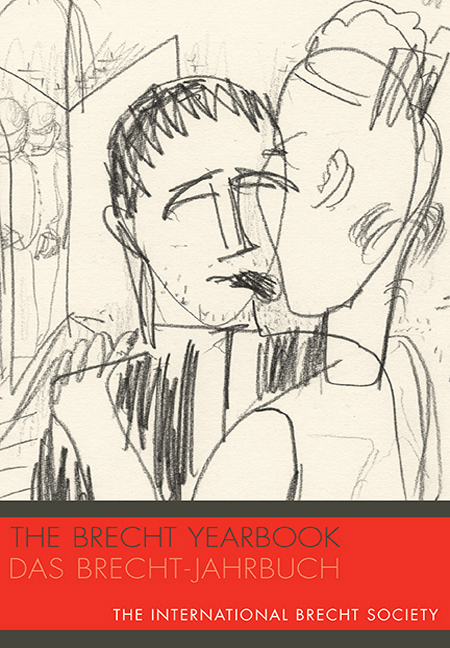Editorial
Published online by Cambridge University Press: 11 March 2017
Summary
Much of the work in the fortieth Brecht Yearbook has to do with forging images that grow out of then re-enter experience—either Brecht's experience of his own time, or others’ experience of Brecht's work and their times. This dynamic is perhaps most concrete in the engaging and illuminating set of graphic works from Berlin artist Dieter Goltzsche, one of which also graces the cover, but it manifests itself across the range of contributions.
The opening section of the volume includes the first of the Goltzsche images, which were created in response to his experiences of Brechtian theater in Berlin, as well as a brief introductory statement by the artist. Thirteen further pieces, ranging from the 1960s to 2015, are ordered chronologically and interspersed throughout the volume. We are grateful to Dieter Goltzsche for the opportunity to share his work with our audience. Following the Goltzsche statement and first image is an open letter to Brecht from Hans-Thies Lehmann and Helene Varopoulou, offered in the context of the inaugural DURCHEINANDER theater project in August 2015. A brief statement from the project organizers accompanies the letter, and both documents wrestle with questions of how to draw on Brecht in today's efforts to renew theater as form and act, re-functionalize it as space, re-imagine and reclaim its aesthetic and political impact.
The volume's first two research articles focus on Brecht's efforts to see and show crucial components of modern life. With specific attention to the Jae Fleischhacker project and Brecht's and Hauptmann's thinking about theatrical representation of the markets and trading world of the mid-1920s, Matthias Rothe analyzes how epic manipulations of time dismantle a suspense-based mode of narration (Erzählen mit Arglist) and enable a narrative and performative stance that has greater capacity to expose two things: the contingency of social and economic structures like futures trading and the limits of causal reasoning as a tool for understanding such structures. Thomas Pekar elucidates the different meanings of Apparat in Der Ozeanflug in order to assess the impact of Brecht's affirmative stance toward technology on his conceptualization and artistic framing of the re-fitting of the human subject that the technological transformation of interwar society catalyzed.
- Type
- Chapter
- Information
- The Brecht Yearbook / Das Brecht-Jahrbuch 40 , pp. ix - xiPublisher: Boydell & BrewerPrint publication year: 2016

